
Externals
The case is a standard midi tower with four 5.25" bays and 3.5" bays. It's really no different from your normal steel and plastic box but this is Commodore branded here, there and everywhere.There is Commodore branding on the inside of door, drive bays, side panels and the case front. The logos are embossed meaning that even though it's everywhere, it isn't in your face, and although the side panel fan is very obvious, the grill sits flush against the side. Even though Commodore seemed very proud of it, we found the PSU branding to be a little over the top.
The second 3.5" bay contains the front panel connectors concealed behind a pop down tray. The usual two USB 2.0, one 6-pin Firewire connector and 3.5mm headphone and microphone sockets are contained within. It has been definitely been thought through, as it gently pops out to face upwards allowing easier use of the connectors, since most cases will usually sit on the floor.
More importantly it means you can plug things in and still close the case door. External hard drives can easily be put on top of the case, although the cables will likely drag across the front bays. Disappointingly, the pop out panel is a little flimsy and you can quite easily pull it out too far if you're not careful. There is no eSATA, which is a real shame because there is none on rear of case either, and if you're the type to spend a lot of money on performance equipment you'll likely want a performance external hard drive if that's your preferred method of backup.
The door is on a double metal hinge and swings round through 270 degrees, but it doesn't lock in place when it's open all the way. Some might not like to use a door, but it's certainly not flimsy and the latch it pretty hard wearing. What doesn't seem quite as hard wearing is the pieces of plastic that support the hinge: we are quite sure our sample machine is one of the machines that was being used all the way back at CeBit in March, so the door has been well used and the plastic looks clearly worn. That's not to say the door doesn't work or feel still just as strong though, but in the couple-to-several year future it might not last the distance. But in any case will you be upgrading by then?
Oh, and that's not a case skin like we've previously seen, but a "C-Kin". From what we can tell, the external coating has been baked on, then a shiny lacquer is added to make it completely unremovable and extremely hard wearing. It is NOT a sticker you can just peel off: the finish is very smooth and precise and is certainly professionally done. Unfortunately, the C-Kin we were sent really wasn't that nice (certainly no one in the office favoured it), but there is a massive range to choose from on the Commodore Gaming webshop. Back at CeBit we were told that they were investigating methods of uploading your own and Commodore had this to say on its current position:
"We will be offering people the ability to customise C-kins within certain parameters i.e. reserved spaces within a C-kin design template to add personal content. There are issues to do with the nature of the content that will always be a challenge to overcome. However, for LAN teams or other groups who want to order more than a couple of systems, we will provide a bespoke service to create a customised C-Kin based on their design. They just need to get in touch with us directly."
Of course, if you don't want a "2C-Kin" you can just buy the case in plain black and have a clean, and unintrusive PC.
The front fan is a standard 120mm and the side fan is a larger 200mm. There are no dust filters included, just a grill to keep your pinkies intact - there will be no "Will it Blend" reenactments here. Both of these fans are Commodore branded and feature an RGB LED array which can vary the colour at the touch of a button. The rear fan is a standard low-noise Arctic Cooling 120mm, so you still get a quality product even if this one is just in plain black.
The black Samsung DVD-RW and black card reader fits with the case aesthetics, and therefore don't require stealthing because the door keeps them hidden. The external appearance still doesn't look that special though, compared to the customisation a Dell, Alienware or even Vadim receives: underneath the case seems very ordinary.
The buttons fit nice and discretely around the front fan, and thankfully Commodore even includes a reset switch (which is more than can be said for quite a few of the cases we've recently had in the labs)! There are two additional buttons to change the LED fan colours for the front and side fans, and if lit fans aren't you're thing or you want to sleep with the PC on (for which, lights will be the least of your problems), you can cycle through and turn the LEDs off completely.

MSI MPG Velox 100R Chassis Review
October 14 2021 | 15:04

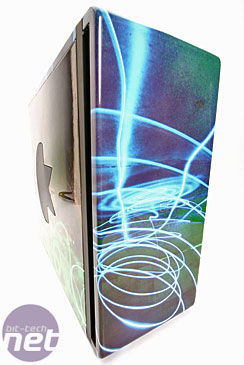

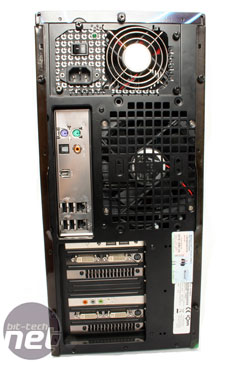
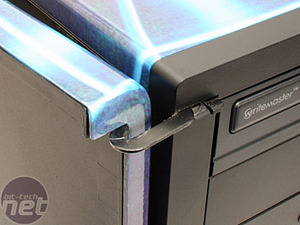
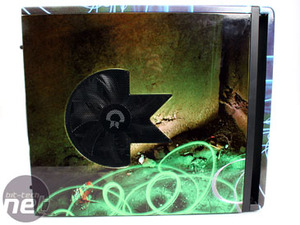

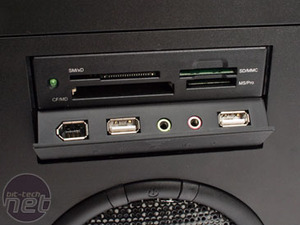







Want to comment? Please log in.